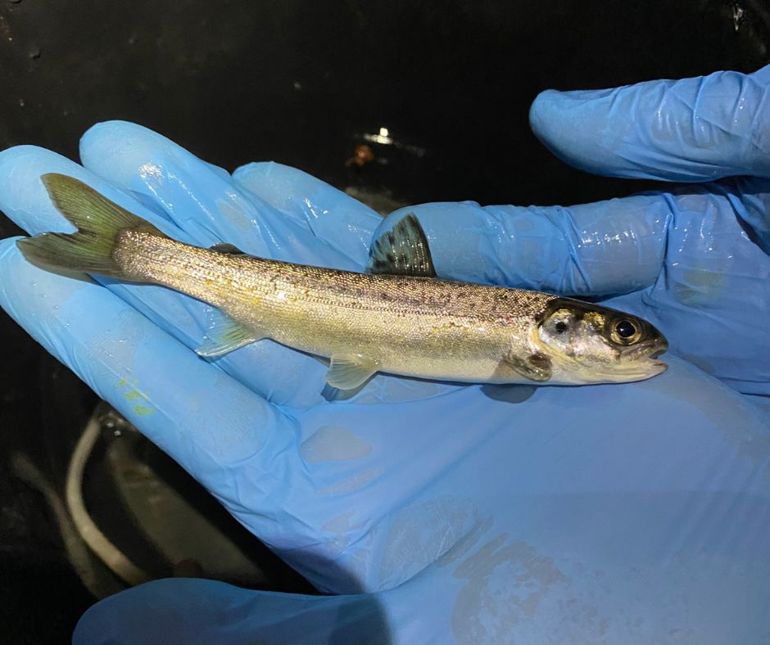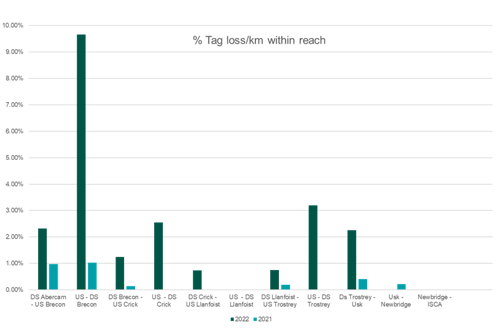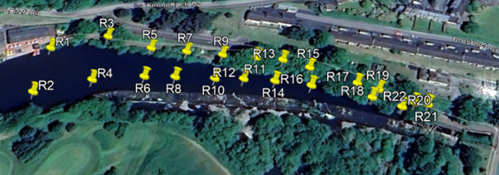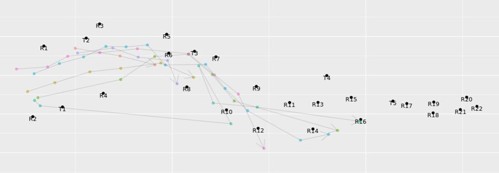Innovative research shines a light on behaviour of young salmon

The Natural Resources Wales (NRW) River Usk Smolt Telemetry Project is revealing previously unknown information about smolt (young salmon) behaviour and the challenges they face.
Oliver Brown leads the smolt project and in this blog in collaboration with the NRW Four Rivers for LIFE Project he talks about the research and the conservation efforts being done to help them.
Atlantic salmon in decline
In 2023, (figures revealed that Wales recorded the lowest catches of salmon in its rivers (252 nets, 848 rods) since consistent records began in the 1970s.*
This represents a 4% decline from the previous year. More worryingly, it shows an approximate 70% decline over the past 10 years.
All 23 principal salmon rivers in Wales are now categorised as being “At Risk”. This decline is demonstrated on the River Usk - once one of the best salmon rivers in Wales.
These days, numbers of salmon caught by anglers in the Usk are at an all-time low. In 2023 a rod catch of only 51 salmon was reported.
In 2023 Atlantic salmon were placed on the IUCN Red List of endangered species as a result of a 30-50% decline in British populations since 2006.
Considering the uncertain future of Atlantic salmon across Britain, and in particular the falling population of Usk salmon, it is vital that as many smolts (young salmon) as possible make it safely down the river and into the marine environment.
Challenges facing salmon in the River Usk
Smolt is the name given to the stage in a young salmon’s life when it migrates to the sea. Free and unimpeded access is critical for this journey.
However, the main stem of the River Usk contains a number of structures, such as weirs and bridge footings, which have the potential to delay the downstream migration of smolts.
As well as slowing down the migration journey, barriers can potentially increase susceptibility to predation too.
This could be through the crowding of migrating smolts as they wait to pass a structure.
Water held above bridge footings or weirs could also provide open areas where predators will forage, as these areas can differ significantly from other more natural parts of the river channel.
Barriers can often force fish to swim over a shallow lip or sill, providing an ideal vantage point for birds to predate the fish.
Research suggests that there is an optimal ‘window of opportunity’ for migrating smolts, and any delays during this crucial time would have a major impact on successful migration.
This ‘window of opportunity’ is based on several triggers such as physiological changes that allow the smolts to make the transition between fresh to salt water, and timings that ensure conditions in the river, estuary and coastal areas are best matched to optimise survival of the smolt.
New research helps shine a light on smolt behaviour
From the middle of March this year NRW officers were again out trapping and tagging smolts on the upper reaches of the River Usk as part of the River Usk Smolt Telemetry Project.
After 13 nights (smolt are more likely to migrate at night) the required number of smolts were caught with the last fish tagged during the early hours of 10 April. Due to the low flows, the fish were caught in fyke nets stretched across the river. Fish were implanted with a small acoustic tag and, after recovery, released to continue their journey.
Fish don’t often behave as we expect, so it is essential that work is focused on barriers that are actually having a negative impact.
Acoustic tagging helps us track the movements of the smolts during their migration to the sea as they pass a series of underwater listening devices deployed along the river. This allows us to see where they are at any given time, plus where they might be experiencing mortalities and delays.
Data from 2021 and 2022 (see Image 1 below) have specifically highlighted that Brecon weir on the River Usk, is causing an increase in mortality for smolts migrating downstream under certain conditions.

Image 1: Graph shows data from 2021/22 indicating areas of tag loss/mortality on the River Usk
Through the use of fine scale tracking techniques, the project is showing how fish are currently navigating the weir.
A large number of listening devices have been installed in the area above the weir (see Image 2 below), R1 to R22 are listening devices.

Image 2: R1 to R22 are the location of listening devices at Brecon weir.
By using a speed of sound model and distance/time calculations we are able to plot the positions and trace the movement of individual fish rather than simply looking at presence or absence. Image 3 below shows the swimming tracks of seven smolt as they swim above Brecon weir in 2024.

Image 3: shows the swimming tracks of seven smolt swimming above Brecon weir in 2024.
Fine scale tracking was first attempted in 2024, but low numbers of smolts caught and high water levels – meant the fish could easily pass over the weir crest, so there was limited value to the data.
The concept, however, proved to be sound with the technology working well, even in less than ideal conditions.
With the low flows experienced this year (2025), and by using previous years data as in Image 3 above, the project is hoping to get a useful insight into how fish navigate the weir and whether they use any of the existing fish passes.
In previous years, the project has gathered data in wet and dry springs, and has shown that tagged fish do experience significant delays at certain structures, which is further compounded by low flows in dry years.
River levels have a huge effect on both passage speed and survival. Tracking data has shown that, in a dry year, only 24% of tagged smolts successfully reach the sea, rising to 67% in a wet year.
Results also showed that not only were the numbers of fish reaching the sea lower in a dry year, they were in fact taking longer to leave the river – five weeks longer in some instances. Some fish were spending in excess of a month trapped above Brecon weir.
Preliminary data for 2025
Data downloads for 2025 will be complete within a few weeks with analysis taking place over the Autumn. But some preliminary data for 2025 are available from selected listening devices.
This shows us that a minimum of 71 of the 76 tagged smolts made it 4km downstream from the tagging site at Penpont to the second listening device at Llanspyddid, which is 2km above Brecon weir.
The image below shows individual smolts represented by a coloured square with the time they were detected at Llanspyddid station on the bottom axis (X axis).
The fish can be seen trickling down after being tagged and released back into the river with a further push of fish making good use of the first significant rainfall and subsequent rise in water levels coming down past Llanspyddid station in a cluster on the 16 April.

Image 4 above: Graph shows smolt tag detections at Llanspyddid station in 2025.
A helping hand for smolts
The project and its vital research has provided evidence to support improvements that are happening this year on the River Usk as part of the Four Rivers for LIFE project.
Works to improve smolt passage over the weir are planned this July. A new smolt pass will be installed, creating a passage route (or channel) in the weir for smolts migrating downstream.
An important part of this study will be to use the same fine-scale tracking methodology after the smolt pass has been constructed, to see if and how smolts are utilising the new pass provided.
Through our research we are becoming increasingly aware of smolt loss in the freshwater environment. The influence of both low flows and man-made structures can conspire to increase levels of predation and smolt loss.
Evidence of this type is key to making the right management decisions in light of the current conservation imperative for Atlantic salmon. The project would like to thank all the landowners, angling clubs and other stakeholders that have been involved and supported this research, without which this work would not have been possible.
The River Usk Smolt Telemetry Project is part of NRWs Salmon and Sea Trout Plan of action, which aims to understand and address the many factors contributing to the decline in these fisheries. Watch a video from 2022 about the work here
The Four Rivers for LIFE Project is funded by the EU LIFE Programme with support from Welsh Government and Welsh Water.
To keep up to date with our work you can follow us on as Facebook, X (formerly Twitter) and Instagram or subscribe to our newsletter here
